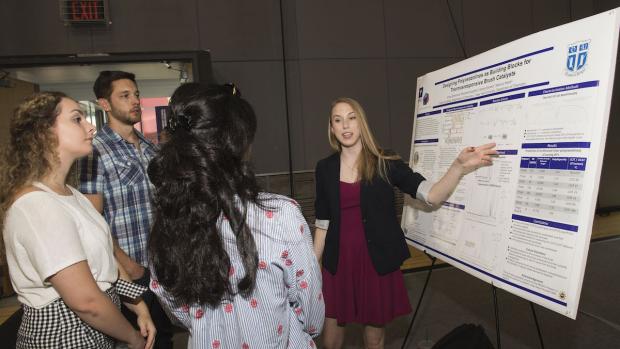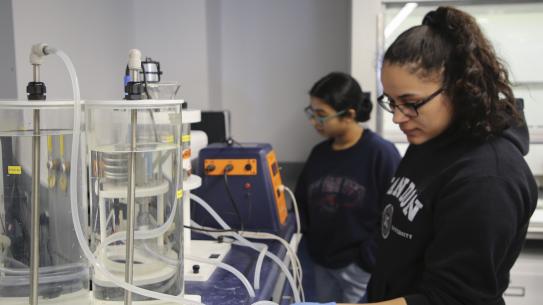When the summer heats up, the research does too
Undergrads showcase their hands-on research

Students shared the results of their research conducted over 10 weeks at the Summer Undergraduate Research Program poster session.
Each summer since 2007, members of the NYU Tandon School of Engineering faculty open their labs to allow undergraduate students to complete 10 weeks of hands-on research. Students work full time in the labs on various research topics while participating in seminars presented by distinguished administrative and academic personnel.
“It’s wonderful to see how motivated the participants are,” said Sara-Lee Ramsawak, the director of Academics and Global Programs, who co-organized the Summer Undergraduate Research Program. “They could have been lounging near a pool somewhere or stretched out binge-watching their favorite show, but they chose to devote their summer to serious scientific inquiry instead.”
Jennifer Piro, the assistant director of Undergraduate Programs, helped organize this year’s initiative and wholeheartedly concurred. “From lab-on-a chip technology to cutting-edge materials science, the projects the students chose to focus on have enormous real-world potential,” she said. “Over the course of the summer, they really honed their skills as researchers, developed valuable relationships with faculty mentors, and learned to present their ideas succinctly. I think they’d all agree that it was a much more enriching experience than camping or going to the beach.”
On August 8, dozens of participants gathered in Tandon’s gym to exhibit posters of their work and present their research findings to attendees. The young researchers included:
Sofiia Barysheva
a rising junior who majors in computer science and wrote in her abstract:
Billions of search requests are addressed daily to major search engines. In order to handle such an extensive workload while staying customer-friendly and satisfying service level agreements (SLAs), agreements that establish limits for the quality and latency of the results delivered, search engines parallelize execution of queries among a large number of machines. To achieve this, the set of documents is split into shards, and shard replicas are assigned to specific machines. Every query then gets routed to many machines in parallel to cover all the shards. Thus, the system of machines can be modeled as a hypergraph, where every hyperedge connects replicas of the same shard and has a certain workload that is distributed among the replicas. In this project we aim to explore local distributed algorithms that repeatedly perform elementary rebalancing steps to converge to an optimal load balanced state. We explore different load rebalancing techniques by creating models in Python and analyzing their results, by comparing the results to the output of a linear solver for the same problem, as well as defining and calculating potential functions that converge to zero when the system is balanced.
The ultimate result, she explained, could be quicker, more efficient searching for Internet users.
Joey Cain
a rising sophomore who majors in math and wrote in his abstract:
In the late 1960s the Bardeen-Cooper-Schrieffer (BCS) Theory of Superconductivity was discovered, accurately modeling superconductive behaviors of materials of a single band, and through research, this theory has been extended to multiband equations. To date, we understand a material’s superconductive properties if we assume that the coulomb and phonon interaction between electrons can be simplified into a constant, or even positive, kernel. However, it is universally accepted that this is an oversimplifying assumption. Our research surveyed single and multiband BCS theory as well as doped graphene models, and we proposed a new, more generalized model in which the kernel is not necessarily constant. Our results include the existence of superconductive behaviors below a certain critical temperature; the theorem is summarized to the right.
Asked what practical applications his admittedly complex work could have, Cain explained that consumers might find their electric bills lowered.
Allie Karakosta
a rising junior who majors in chemical and biomolecular engineering and wrote in her abstract:
B-cell acute lymphoblastic leukemia (B-ALL) is the most common cancer in childhood and the leading cause of cancer-related deaths in children. Adoptive CD19 CAR (Chimeric Antigen Receptor) T-cell transfer has emerged as a successful FDA-approved therapy for B-ALL patients. Despite this, the durability of patient remission remains unpredictable largely due to CAR T-cell immunological resistance and insufficient target engraftment from the dynamic, immunosuppressive and protective leukemic bone marrow (BM) niche/microenvironment. Herein, we engineered a three-dimensional microfluidics-based, “biometric” niche model (termed “Leukemia-On-A-Chip”) that contains key immune populations and essential tumor-immune-stroma intercellular communications. This “Leukemia-On-A-Chip” platform allows visualization between the interactions of B-ALL leukemia blasts with the bone marrow microenvironments ex vivo. Preliminary investigations are necessary before in-depth analysis of the microdevice. Therefore, we have deeply studied the relationship between the genetic-specified B-ALL subtypes and immunophenotype of tumor-associated macrophages, which could be further interrogated to elucidate the immunosuppressive cues in regulating CAR T-cell therapy. We believe this leukemic BM niche model can be applied to optimize and screen efficient CAR T-cell therapy, which will finally improve disease-free long-term survival in pediatric and adult B-ALL patient.
Her work, she explains, could serve as a bridge between often-ineffective 2D modeling and expensive (and problematic) animal trials.





